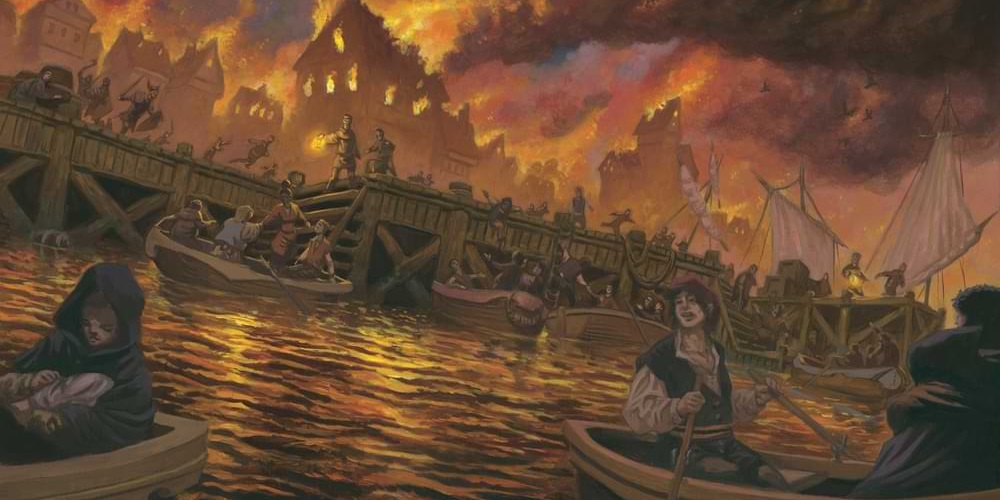It's very much an adventure, not a setting sourcebook. It does an excellent job of zeroing in on the setting info that you NEED to have to run the adventure without attempting to give you the whole world of Krynn or continent of Ansalon. The setting and backstory info it does provide is succinct, readable, and interesting.
We don't NEED a sourcebook, btw. Players and DMs who ran the original DL1: Dragons of Despair module when it first came out in the 80s did so with only a 30 page book to work from. There was no setting sourcebook until much later.
I think an adventure is a great way to introduce a setting. WotC in 5E has done this very effectively with Curse of Strahd, Tomb of Annihilation, and Icewind Dale: Rime of the Frostmaiden, and less effectively with other adventures including Waterdeep: Dragon Heist
In keeping with the setting, it's implied that in terms of races, players should pretty much be running humans, elves, dwarves, gnomes, or kender. If players want to run other races (such as tieflings or dragonborn), they can, but some rationale will be needed (like they came through a portal from another world). Dwarves are hill or mountain; gnomes are forest or rock; elves are high, wood, or the sea elf from Mordenkainen's Monsters of the Multiverse. Kender have no sub-races; their mechanics are fine but I don't think anyone is going to be dying to play them for the mechanics alone.
Some other races that have traditionally been playable in Krynn in earlier editions, such as minotaurs, are not mentioned.
I have not encountered any refences so far to gully dwarves, so they may have been wisely omitted.
There are two new backgrounds, Knight of Solamnia and Mage of High Sorcery. Both are well done and it would definitely add to the campaign to have at least one player using each. Both of these backgrounds include a feat.
ALL characters start with a feat at level 1. If you don't have one of the backgrounds with a feat, you get to choose either Skilled or Tough.
Everyone also gets a free feat at level four - there are 4th level feats for the Knight and Mage that have pre-requisites. Barring that, you get to choose from Skilled, Tough, Alert, Mobile, Sentinel, War Caster, or a new feat, Divinely Favored.
In terms of balancing characters vs encounters, theoretically the free feats should lead to an arms race where the adventure has to ramp up all the encounters in order to challenge tougher adventurers.
In practice, however, like most official WotC books, the designers here treat encounter balance as more art than science and largely ignore their own CR system. The result, as usual, is that on the whole the encounters as written are mostly too deadly at levels 1-2, about right at levels 3-4, and mostly too easy thereafter. DM is left to fix it but if you’ve run a few WotC hardcovers you’re used to that by now
The Knight and Mage also get unique Trinket tables to roll on.
The Knight and Mage backgrounds are not really class-gated. It says that most Knights are fighters or paladins, but there are also War Domain clerics and some Valor bards and Zealot barbarians among their ranks. Most Mages of High Sorcery are Wizards, Sorcerers, are Warlocks, but it's implied that there are some Eldritch Knight fighters and Arcane trickster rogues among them.
I haven't compared it with a fine tooth comb, but the new Lunar Sorcerer subclass seems quite similar to the UA version.
Chapter 2 provides a broad overview of the adventure which seems in general to be rather linear except for a sandbox section in chapter 5. It covers levels 1-10, but advancement through levels 1-3 seems VERY rapid. It would actually make more sense to just start everybody at level 2 rather than advancing them after the prologues in which they have to do VERY little.
Chapter 2 also provides a story hook to unite the characters physically in the small town of Vogler in Solamnia. It's the funeral of a mutual friend. I've seen this trope used before to start campaigns, but I'm a big fan of re-using good ideas and it's done well here, with the DM and players collaborating on developing the details of their relationship with the NPC.
They integrated the board game FAR more than I expected they would. There are multiple points throughout the adventure where call-out boxes tell you when you could use it to resolve a battle.


 www.dndbeyond.com
www.dndbeyond.com



